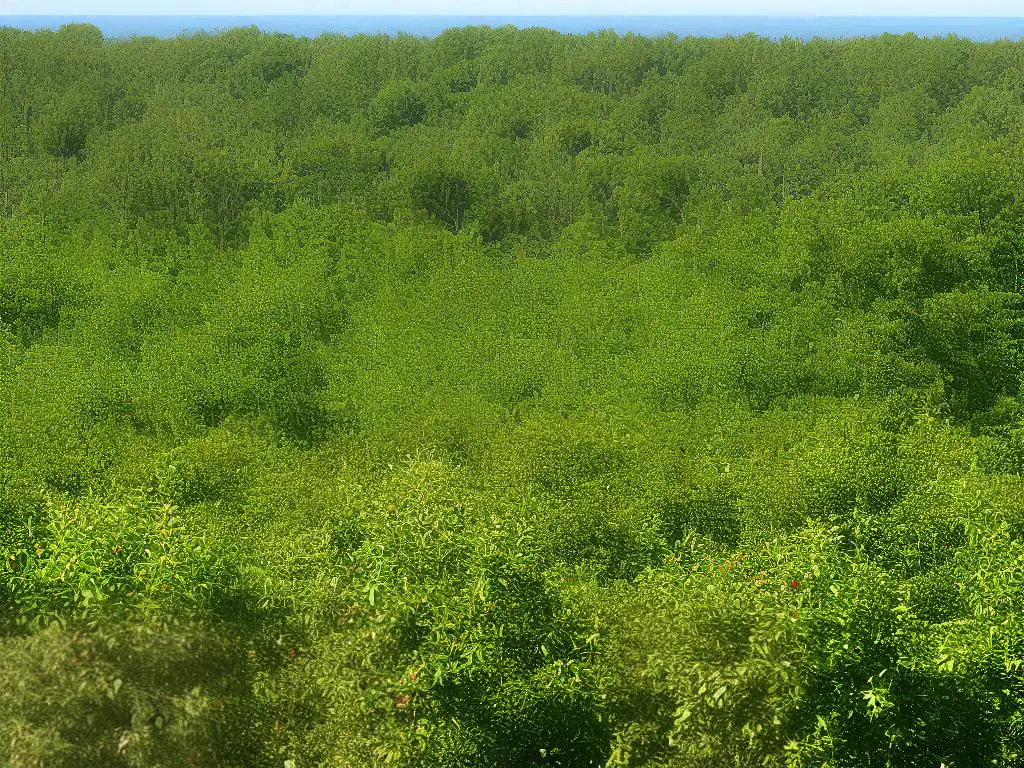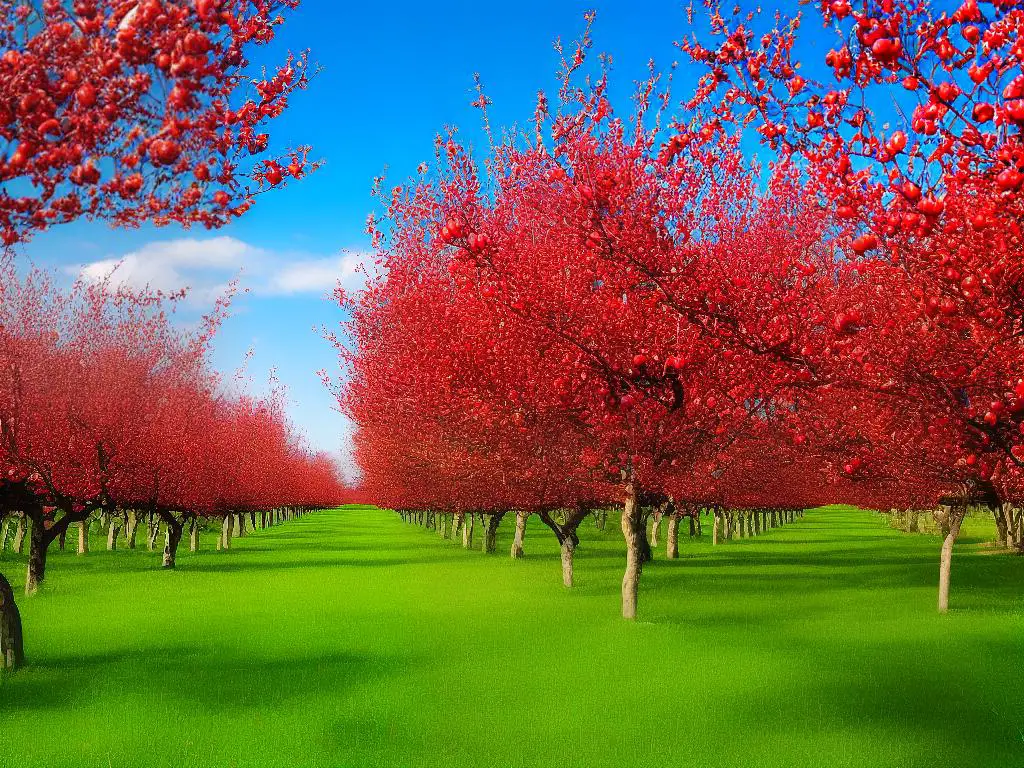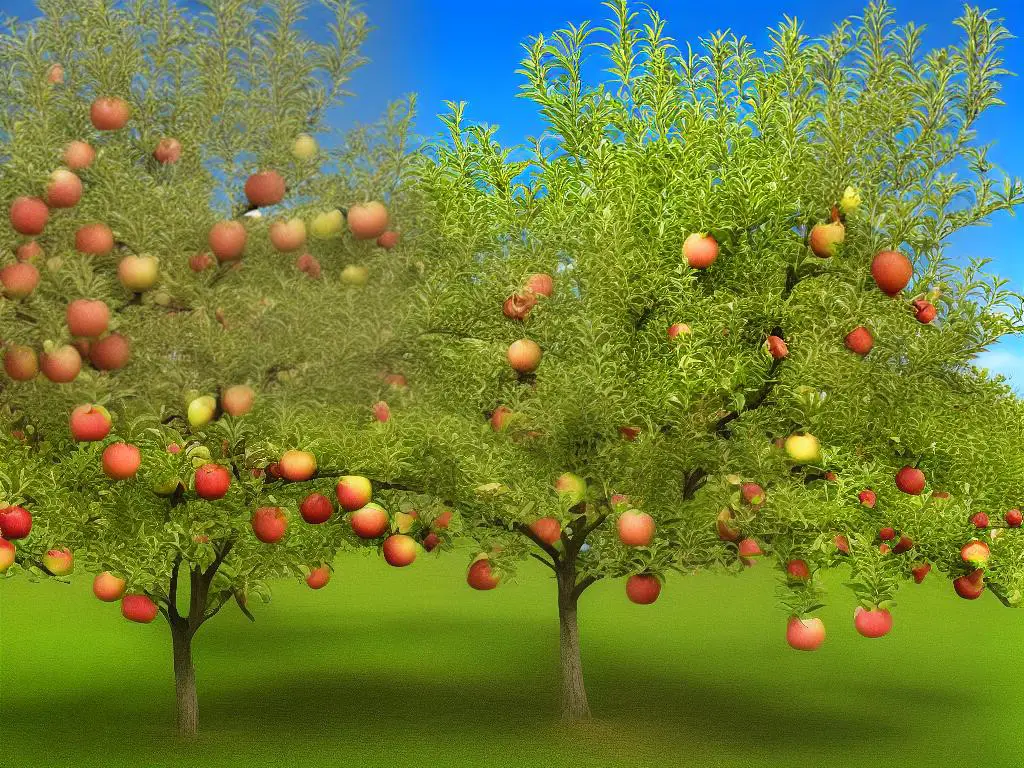Growing your own apple trees can be a rewarding experience, providing you with delicious fruit and a beautiful addition to your landscape. To successfully cultivate apple trees, it’s essential to understand the factors that contribute to their growth and overall health. This article will explore the various aspects of planting and maintaining apple trees, including choosing the appropriate variety for your climate, understanding soil and sunlight requirements, learning proper planting techniques, and scheduling water, fertilization, and maintenance in order to ensure a bountiful harvest.
Understanding Apple Tree Varieties
Growing apple trees can be a rewarding experience for both novice and experienced gardeners. However, it is essential to understand the variety of apple trees to ensure successful growth and healthy fruit production. This guide will introduce you to different apple tree varieties, their growth habits, ideal climates, and cross-pollination requirements.Apple trees come in various growth habits, such as dwarf, semi-dwarf, and standard.
a) Dwarf apple trees: Dwarf trees are relatively small, usually growing to 8-10 feet in height. These trees are suitable for small gardens and are easy to maintain and harvest. Popular dwarf varieties include ‘Gala,’ ‘Golden Delicious,’ and ‘Braeburn.’
b) Semi-dwarf apple trees: These trees can reach heights of 12-15 feet. They produce more fruit and require a larger space compared to dwarf trees. Semi-dwarf varieties include ‘McIntosh,’ ‘Red Delicious,’ and ‘Granny Smith.’
c) Standard apple trees: These trees can grow up to 20-30 feet high and require more space and maintenance. They produce abundant fruit but may take a few years to reach maturity. Popular standard varieties are ‘Winesap,’ ‘Fuji,’ and ‘Rome.’Apple trees enjoy various climates, depending on the variety. However, most apple trees require adequate chilling hours to produce fruit. These hours refer to the time when temperatures are below 45 degrees Fahrenheit.
a) Warm climates: Varieties such as ‘Anna,’ ‘Dorsett Golden,’ and ‘Ein Shemer’ require fewer chilling hours, making them suitable for warm climates.
b) Cold climates: Apple tree varieties like ‘Haralson,’ ‘Honeycrisp,’ and ‘Zestar!’ are more cold-hardy, making them ideal for colder climates with longer winters.Most apple tree varieties require cross-pollination for successful fruit production. This process involves the transfer of pollen from one variety to another, typically achieved by bees or other insects.
a) Self-fertile apple trees: Some apple tree varieties, like ‘Golden Delicious’ and ‘Rome,’ can self-pollinate, meaning they can produce fruit without a pollinator tree nearby. However, they may still produce more abundant and better fruit with cross-pollination.
b) Cross-pollination partners: To ensure good fruit production, plant at least two apple tree varieties nearby each other. Choose varieties that bloom simultaneously for successful pollination. For example, ‘Cox’s Orange Pippin’ pairs well with ‘Gala,’ ‘Granny Smith,’ and ‘Red Delicious.’Understanding the different varieties of apple trees is crucial for selecting the right types for your garden and ensuring their proper growth. Consider factors like growth size, ideal climate conditions, and cross-pollination requirements when choosing apple trees for your garden. With the right care and attention, you’ll enjoy a bountiful harvest and the satisfaction of growing your own apples for years to come.

Soil Requirements for Apple Trees
Planting apple trees in the right soil is essential for their healthy growth and bountiful fruit production. Here are some guidelines to follow when assessing your soil before planting apple trees:
1. Soil pH level:
Apple trees thrive in slightly acidic to neutral soil with a pH level between 6.0 and 7.0. You can purchase an inexpensive soil pH testing kit at your local garden center or online to test your soil’s acidity. If the pH is too low (acidic), you can add lime to increase the pH. If the soil pH is too high (alkaline), you can add sulfur or peat moss to lower it. It’s essential to make these adjustments to your soil before planting your apple trees.
2. Soil drainage:
Good drainage is crucial to ensuring that apple trees establish a healthy root system. Apple trees will not thrive in waterlogged, poorly drained soil, which can lead to root rot and other diseases. To test your soil’s drainage, dig a hole that is about 1 foot deep and 1 foot wide. Fill the hole with water and wait for it to drain completely, then fill it again. If the water takes longer than eight hours to drain, your soil drainage may be inadequate. In this case, you can improve drainage by creating raised beds or planting your apple trees on a slope to help excess water flow away from the roots.
3. Soil composition:
Ideally, apple trees prefer well-aerated, loamy soil that is rich in organic matter, but they can also tolerate a range of soil types, including sandy, clayey, and rocky soils. To improve soil composition, you can incorporate organic matter such as compost or well-rotted manure into your planting site, which will enrich the soil and improve its structure. Additionally, you can add a layer of mulch around the base of your apple trees after planting to help retain moisture, regulate soil temperature, and suppress weeds. Just be sure not to let the mulch touch the trunk of the tree, as this can lead to rot or pests gaining access to the tree.
4. Soil fertility:
Apple trees require a balanced supply of nutrients, including nitrogen, phosphorus, and potassium. Conduct a soil test to determine the nutrient levels in your soil and follow the recommendations provided to amend your soil as necessary. Many garden centers and university extensions offer soil testing services for a reasonable fee. Once your apple trees are established, consider fertilizing them annually in the spring with a slow-release, all-purpose fertilizer to support healthy growth and fruit production.
By ensuring that your soil meets the requirements for apple tree growth, you’ll be well on your way to enjoying a healthy and productive apple orchard in your backyard.

Climate and Sunlight Considerations
Growing apple trees requires choosing the best location for planting them. The climate and sunlight exposure in the area should be considered.Apple trees grow best in moderate climates and USDA Hardiness zones 4 through 8. Chill hours, ranging between 500 to 1,000 hours between 32°F and 45°F, are also required. For optimal growth and fruit production, apple trees need at least 6 hours of direct sunlight daily. Planting in areas with southern or southeastern exposure is recommended. When choosing a location for planting an apple tree, the terrain, airflow, and drainage should be checked.Apple trees need ample space for planting, and proper spacing is vital for sunlight and proper air circulation.Possible shading and obstructions from nearby buildings, walls, and large trees should be considered too.

Spacing and Planting Techniques
Researching and Selecting Apple Tree Varieties
To ensure a fruitful harvest, research and select appropriate apple tree varieties. Determine your regional climate or USDA hardiness zone to understand which varieties will thrive in your area. Choose varieties that are compatible for cross-pollination as most apple trees require another tree of a different variety for successful pollination and fruit production.
Preparing the Planting Area
Select an area with well-draining soil and plenty of sunlight for your apple trees. Test the soil pH to ensure it is between 6.0 and 6.5, which is ideal for apple trees. Clear the planting area of any debris or weeds.
Determining Proper Spacing
Proper spacing is essential for the healthy growth of your apple trees. Consider the mature size of the trees. Standard apple trees need 20 to 25 feet of spacing between each tree. Dwarf and semi-dwarf varieties require 8 to 12 feet and 12 to 15 feet, respectively. Ensure adequate spacing between rows.
Digging the Planting Hole and Planting the Tree
To plant your apple trees dig a hole twice the width and the same depth as the root ball of the tree. Position the tree in the hole and spread the roots around the mound of dirt in the planting hole. Fill the hole with soil and water thoroughly. Apply mulch around the tree to help retain moisture and regulate soil temperature. Install a tree guard or mesh tube to protect the trunk for pests and lawn equipment. Prune annually to encourage proper shape and growth.

Watering and Fertilization Needs
Planting apple trees in your garden or yard can be rewarding and fruitful (pun intended). To ensure a healthy growth and harvest, it’s essential to know the proper watering and fertilization techniques. Here are some guidelines to follow:- The first few weeks: New apple trees require consistent watering to establish strong roots. For the first two weeks after planting, water the tree every day to keep the soil evenly moist. Use a slow and steady flow of water, allowing it to penetrate the soil without causing runoff.
– The first year: After the initial two weeks, gradually decrease the watering frequency to once every 7-10 days. You may need to water more often during hotter weather or if your soil is sandy and drains quickly. Ideally, the soil around the tree should be moist, but never soggy.
– Subsequent years: As the apple tree matures, its roots will extend deeper into the soil, allowing it to access more water. In general, you can reduce watering frequency to every 10-14 days, depending on weather conditions and your soil type. During warmer months, it’s essential to provide enough water to maintain healthy growth.
– Proper watering technique: Use a soaker hose, watering bag, or drip irrigation system to deliver water directly to the root zone, which encourages deep rooting. Avoid using sprinklers or watering the leaves, as this can contribute to the development of diseases. Your goal is to provide about 1-1.5 inches of water per week, including rainfall.- Soil test: To determine the appropriate fertilization for your apple tree, start by conducting a soil test. This will help you understand the existing nutrient levels and pH balance, which will guide your fertilization decisions.
– Nitrogen: Apple trees primarily require nitrogen for healthy growth. Generally, a young tree benefits from 1/8 to 1/4 pound of actual nitrogen per year. Increase this amount to 1/2 pound for a mature tree. You can use a granular or liquid variety, such as ammonium, calcium nitrate, or urea.
– Timing: The best time to apply fertilizer is in early spring, just before the tree starts to bud. If the tree has a lighter-than-normal fruit set, you can apply a second application in early June. Avoid fertilizing after mid-August, as this can promote new growth susceptible to winter damage.
– Application: For granular fertilizers, spread the recommended amount evenly around the tree’s drip line (the area underneath the outer reach of the branches). Keep the fertilizer at least 6 inches away from the trunk. For liquid fertilizers, mix the suggested ratio with water and apply it to the root zone.
– Monitoring: Regularly observe your tree’s growth and appearance, adjusting your fertilization practices as needed. A healthy apple tree will typically grow 8 to 12 inches per year. If the tree produces fewer leaves, has a weak leaf color, or exhibits a lower-than-expected growth rate, consider additional fertilization.

Pest and Disease Control
Objective:
Learn how to identify and manage pests and diseases common to apple trees, as well as preventive measures.
Introduction:
Planting apple trees can be a rewarding endeavor, providing you with delicious fruit and a beautiful landscape addition. However, pests and diseases can threaten the health and productivity of your apple trees. In this guide, we will discuss how to identify common pests and diseases, as well as preventive measures to ensure a healthy, bountiful harvest.
Materials:
- Gardening gloves
- Pruning shears
- Insecticidal soap or spray
- Fungicides
- Horticultural oil
- Sticky traps
Instructions:
-
Monitoring for pests and diseases:
- Regularly inspect your apple trees for any signs of pests, diseases, or general tree health issues. Look for discolored leaves, holes in leaves or fruit, and any other visible signs of damage.
- Familiarize yourself with common apple tree pests and diseases, so that you can accurately identify problems when they occur.
-
Common Apple Tree Pests:
- Apple maggot: Small, brown and white flies that lay their eggs inside the apples, causing the fruit to become soft and mushy.
– Control: Place sticky traps on tree branches to catch the adult flies. Remove and destroy any infected fruit to prevent further damage. - Codling moth: Small, gray moths that lay their eggs on the surface of the fruit, leading to worm-infested apples.
– Control: Apply a horticultural oil spray to the tree during the dormant season to kill overwintering larvae. Set up pheromone traps to monitor and catch adult moths. - Aphids: Small, pear-shaped insects that suck the sap from apple tree leaves and shoots, causing curling and distortion.
– Control: Use insecticidal soap or a strong spray of water to dislodge and kill aphids. Encourage natural predators, such as ladybugs, to help control aphid populations.
- Apple maggot: Small, brown and white flies that lay their eggs inside the apples, causing the fruit to become soft and mushy.
-
Common Apple Tree Diseases:
- Apple scab: Fungus that causes dark, scabby spots on leaves and fruit.
– Control: Apply a fungicide spray during the growing season to protect new leaves and fruit. Prune tree to improve air circulation and promote drying of the foliage. - Fire blight: Bacterial disease that causes blackened, dead branches and fruit.
– Control: Prune out infected branches, cutting at least 6-12 inches below the visible infection. Disinfect pruning shears in a 10% bleach solution between cuts. Apply a copper-based bactericide during the dormant season to prevent infection. - Powdery mildew: White, powdery fungal growth on leaves and shoots, which can cause leaf distortion and poor fruit development.
– Control: Apply a fungicide spray during the growing season to protect new growth. Prune tree to improve air circulation and promote drying of the foliage.
- Apple scab: Fungus that causes dark, scabby spots on leaves and fruit.
-
Preventive measures:
- Choose disease-resistant apple tree varieties whenever possible.
- Plant your apple trees in well-draining soil and provide adequate spacing to promote good air circulation.
- Water apple trees deeply and consistently to maintain good tree health. Avoid overhead watering, as this can contribute to the spread of diseases.
- Keep the area around your apple trees free of weeds, fallen leaves, and fruit to reduce potential sources of infection.
- Regularly prune your apple trees to maintain a strong, healthy structure and to promote good air circulation.
Conclusion:
By regularly monitoring your apple trees for pests and diseases and taking timely action when problems arise, you can enjoy the fruits of your labor and maintain the health and productivity of your trees. Use these instructions as a guide to ensure a successful apple harvest for years to come.

Pruning and Maintenance
Pruning and maintaining apple trees are essential tasks for ensuring optimal growth and fruit production. By understanding the basics of pruning and performing proper maintenance, you can enjoy a healthy and bountiful apple harvest. Here are step-by-step instructions to help you get started:1. Choose the right time to prune: The best time to prune apple trees is late winter or early spring, before new growth begins. This allows you to remove any dead or damaged wood, improve the tree’s structure, and encourage fruit production. Avoid pruning during the fall, as it can make the tree more susceptible to damage from cold weather.2. Gather the necessary tools: To prune apple trees, you’ll need a pair of sharp bypass pruners, loppers, and a pruning saw. Make sure your tools are clean and sharp to make clean cuts and minimize the risk of infection.3. Understand the tree’s structure: Apple trees have a central leader (main trunk) that should be the tallest part of the tree, with scaffold branches (main side branches) evenly spaced around the leader. The goal of pruning is to maintain this structure while removing any branches that do not contribute to the tree’s overall health and fruit production.4. Start by removing dead, diseased, or damaged branches: Use your bypass pruners, loppers, or pruning saw to remove these branches. Make your cuts close to the branch collar (the swollen area where the branch meets the trunk) without cutting into it. This allows the tree to heal more quickly.5. Prune any branches that are crossing or rubbing against each other: This helps prevent damage and reduces the risk of infection. Choose the stronger or better-positioned branch to keep and remove the other.6. Remove water sprouts and suckers: Water sprouts are fast-growing, vertical branches that usually grow straight up from the main branches. Suckers are similar but grow from the base of the tree. Both can divert energy away from fruit production, so remove them as close to their point of origin as possible.7. Thin out crowded areas: If there are too many branches in one area of the tree, it can limit sunlight and air circulation, leading to a reduced fruit yield and increased risk of disease. Aim to have about 6 inches of space between branches, removing weaker branches to leave the strongest and best-positioned ones.8. Shorten long branches: Long, horizontal branches can become weak and break under the weight of fruit. Reduce their length by up to one-third, cutting back to an outward-facing bud to encourage growth away from the tree’s center.9. Prune the central leader: If the central leader is significantly taller than the surrounding branches, it can shade the lower part of the tree, reducing sunlight and limiting fruit production. Cut it back to around 3 feet above the top scaffold branch or to a height of about 10-12 feet.10. Maintain your tree throughout the year: Regularly check for signs of disease or pests, and remove any infected or infested branches. Keep the area around the base of the tree free from grass, weeds, and debris, as these can harbor pests and diseases. Apply mulch around the tree to help retain moisture, and provide proper irrigation, especially during dry periods. Finally, apply a balanced fertilizer in the early spring, based on the specific needs of your tree and soil.By following these pruning and maintenance instructions, you’ll be well on your way to growing healthy and productive apple trees. Happy gardening!

By taking the time to research and understand the intricate needs of apple trees, from selecting the right variety and location, to providing consistent care and maintenance, you’ll increase your chances of success in growing these delightful fruits. With this knowledge in hand, you’re on your way to transforming your garden into an apple tree haven, and, eventually, enjoying the sweet rewards of your labor.